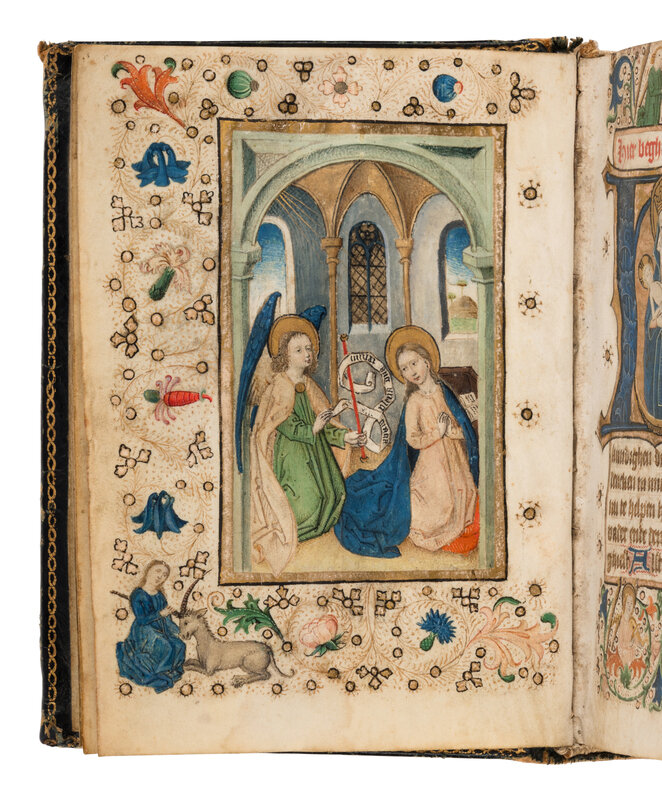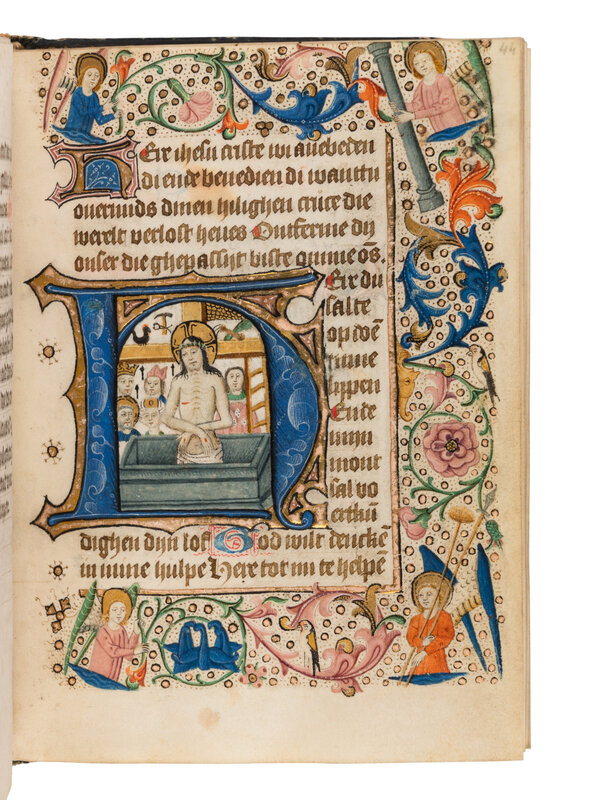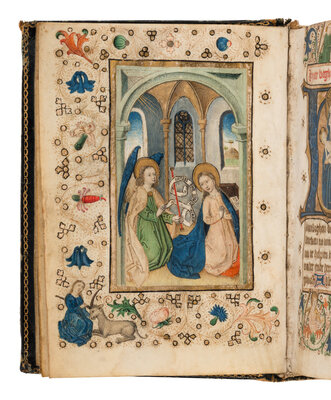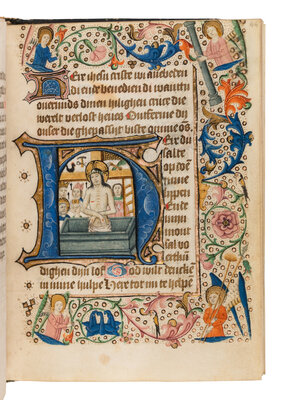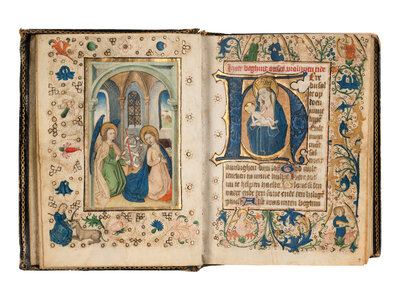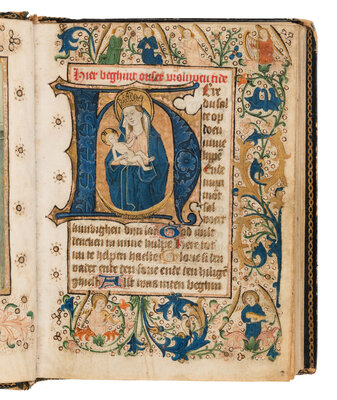Condition Report
Contact Information
Lot 65
MASTERS OF THE ZWOLLE BIBLE (active Eastern Netherlands, Zwolle, c. 1470-1490)
The Hours of Thomas Joffe, use of Geert Grote, in Dutch, illuminated manuscript on parchment [Eastern Netherlands, Zwolle, c. 1470-1480]
The Hours of Thomas Joffe, use of Geert Grote, in Dutch, illuminated manuscript on parchment [Eastern Netherlands, Zwolle, c. 1470-1480]
Sale 2033 - Western Manuscripts and Miniatures
Jun 27, 2024
10:00AM CT
Live / Chicago
Own a similar item?
Estimate
$25,000 -
30,000
Lot Description
MASTERS OF THE ZWOLLE BIBLE (active Eastern Netherlands, Zwolle, c. 1470-1490)
The Hours of Thomas Joffe, use of Geert Grote, in Dutch, illuminated manuscript on parchment [Eastern Netherlands, Zwolle, c. 1470-1480]
The Hours of Thomas Joffe, use of Geert Grote, in Dutch, illuminated manuscript on parchment [Eastern Netherlands, Zwolle, c. 1470-1480]
Seductive example of the Golden Age of Dutch manuscript painting illuminated by the Masters of the Zwolle Bible for a man named Thomas Joffe, who probably lived in Utrecht. It is adorned with a full-page miniature, three historiated initials, imaginative borders, and dazzling illuminated initials in burnished gold.
135 x 100 mm, ii (parchment, the first lined with modern silk) + 140 + iii (parchment, the last lined with modern silk) leaves on parchment, lacking at least five leaves and one quire (collation: i8+1 [f. 1, with miniature, added as a singleton], ii-iii8, iv8-1 [after f. 26, with loss of text], v8, vi4-1 [after f. 40, with loss of text], vii8, viii8-1 (after f. 51, with loss of text], ix8-1 (after f. 63, with loss of text), x4-1 [after f. 65, with loss of text], xi-xiii8, xiv2, [lacking one quire after f. 94, with loss of text and historiated initial], xv-xviii8, xix2, xx6, xxi8), lacking also probably added singletons, perhaps with miniatures or historiated initials, from fourth, sixth, eighth, ninth, and tenth gatherings, else complete, with strings, foliated in pencil in upper right corner, 1-141, ruled in brown for 17 lines (written space: 82 x 55 mm), written in brown ink in a gothic textura hand, rubrics in red, one-line initials alternately in gold and blue, flourished with lilac and red penwork often extending into the margins, two-line initials in burnished gold on red and blue ground with white tracery, extending into hairline stems with gold disks in the margin, TWO FOUR-LINE ILLUMINATED INITIALS with three-sided border of the same, TEN SIX-LINE ILLUMINATED INITIALS with blue staves on a burnished gold ground, in-filled with a leaf or floral sprout, each with an outer baguette border and borders on three sides of foliage, flowers, gold disks, birds, and angels, THREE HISTORIATED INITIALS, accompanied with borders of the same, enclosing twelve angels playing musical instruments, holding the instruments of the Passion or grasping the foliage, and a peacock, the bas-de-page in the last containing the dead rising from their graves below a fiery sky, ONE FULL-PAGE MINIATURE framed with hairline tendrils and disks, illuminated flowerhead, and a Virgin capturing the Unicorn (slight fading to the first opening, trimming at top affecting some borders, else in excellent condition). Bound in an eighteenth-century gilt-tooled black morocco over pasteboards, silk doublures, gilt edges (some scuffs at headbands and splits along spine, else in good condition).
Provenance
(1) Stylistic and textual evidence indicate that this Book of Hours for the use of Geert Grote was illuminated by the Masters of the Zwolle Bible in the Eastern Netherlands, most likely in Zwolle, in the 1470s or 1480s. It would have been commissioned by a man named “Thomas Joffe,” whose late-fifteenth century ex-libris is written in Dutch on the last flyleaf, now covered with silk but visible with UV light through the recto of the leaf. A choice of local saints in the Calendar suggests that he lived in Utrecht (see below).
(2) Christie’s, London, 25 November 1992, lot 14.
(3) European Private collection.
(4) Sotheby’s, London, 2 July 2013, lot 70.
(5) Private collection, New York.
Text
ff. 2-44v, Hours of the Virgin (use of Geert Grote), with Lauds, f. 11, Prime, f. 20, Terce, f. 24, None, f. 29, Vespers, f. 33, Compline, f. 39; ff. 44-68, Hours of the Cross, with Lauds, f. 51v, Prime, f. 54v, Terce, f. 57, Sext, f. 59v, None, f. 62; f. 68v, blank; ff. 69-82, Penitential Psalms; ff. 82v-94, Litany; ff. 96-128v, Office of the Dead, with Lauds, f. 116v (lacking Vespers and opening of Matins); ff. 129-140, Calendar, reading “Sarijs,” with local saints of Utrecht (these include St. Pontianus, 14 January, St. Servatius, 13 May, St. Odulf, 12 June, St. Lebuin, 25 June and 12 November, and St. Wilibrort, 7 November, in red).
Illumination
The large historiated initials, all accompanied by full borders, introduce and mark the beginnings of the separate hours. The restrained illumination and the soft reduced palette are in keeping with the precepts of the Devotio Moderna or Modern Devotion, which opposed showiness or opulent display. This lovely manuscript is a work by the Masters of the Zwolle Bible, a group of artists identified from their production of a sumptuous six-volume Bible for the Community of the Brethren of the Common Life (the lay members of the Devotio Moderna) in Zwolle, between 1462 and 1476 (now Utrecht University Library, MS 31), which was described in the 1989 exhibition as “finely decorated but never excessively or exaggeratedly opulent … [the] colors are kept pale, and the illumination has a quality of extreme lightness” (Defoer, 1989, p.244). The handling of the figures here exemplifies this, and the Virgin with the unicorn on f. 1 in an unusual addition.
In her study of 1995 of a stylistically coherent group of about sixty manuscripts L. Wierda argued that the large production of Books of Hours took place under the supervision of the Brethren of the Common Life at Zwolle at the Gregoriushuis, but was carried out by pupils resident in the adjacent “Domus Parva” (cf. Wierda 1995, p. 169). Apparently, the books were ready-made manuscripts copied from a standard exemplar rather than individually planned commissions. Iconographically, our manuscript conforms to others studied by Wierda that likewise include historiated initials, including a Last Judgment to illustrate the Seven Penitential Psalms. However, the exact identity of our illuminator must remain an open question as all painters from this Zwolle school tended to imitate their limited choice of models very closely. It is the stylistic proximity of all “Sarijs” manuscripts to the dated six-volume Zwolle Bible in Utrecht that suggests a date around 1470 or in the decade thereafter.
A manuscript in the Walters Art Museum is quite close in style and execution, MS 918. In spite of the missing miniatures (probably historiated initials, for this was common in the group’s production), the present manuscript is a fine example of the Zwolle Masters’s style and is in a remarkable condition with much secondary decoration, thickly burnished gold leaf, and very finely painted miniatures with little or no loss of surface detail.
The subjects of the full-page miniature and historiated initials are: f. 1v, Annunciation, with a lady soothing an unicorn in the border; f. 2, Virgin and Child, half-length, with musician angels in the border; f. 44, Christ as Man of Sorrows, surrounded with the Arma Christi, with twelve angels bearing the Arma Christi in the border; f. 69, Last Judgment, with two angels blowing trumpets in the margins, and dead rising from their graves in the bas-de-page.
LITERATURE
For further literature, see James H. Marrow, Henri L.M. Defoer, Anna Sophia Korteweg, and Wilhelmina C M Wüstefeld,
Golden Age of Dutch Manuscript Painting, exhibition catalogue, New York, 1989; Lydia Wierda, De Sarijshandschriften: laat-middeleeuwse handschriften uit de Ijsselstreek, Zwolle, 1989.
Freeman’s | Hindman thank Senior Consultant Sandra Hindman and Elliott Adam for their assistance in preparing this sale.
